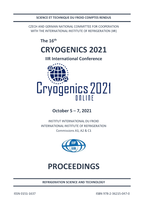
Summary
High-temperature superconductors (HTS) for the transmission of electrical energy in distribution networks or industrial systems consist of ceramic materials which reach their critical temperature close to the boiling point of liquid nitrogen (-196°C / 77 K) and then lose their electrical resistance completely. Because of this physical phenomenon, electrical current can be transported without loss. It is advantageous to set the cooling temperature as deep as possible, because the ampacity of the superconductors is increasing with its difference to the critical temperature. When conventional cables are energetically compared with HTS-cables the savings in ohmic losses which heat up copper or aluminum transmission lines stands against the energetic effort for cooling the HTS-systems. This effort is dependent not only on the required cooling capacity, but also on the cooling temperature and the cooling concept. Superconducting wires are integrated in cable cryostats through which subcooled liquid nitrogen circulates to remove the heat ingress of the cryostat. The circulating nitrogen is recooled in a subcooler, in which liquid nitrogen evaporates under vacuum conditions to generate cold. The evaporation pressure can be reduced to 150 mbar, the evaporation temperature then is -209°C (64 K). Lower temperatures are not practical because the nitrogen freezes at -210°C (63 K). In addition to the ingress of heat through the cable cryostat, hydraulic losses due to the flowing liquid nitrogen and the associated heat input from the circulation pumps are also of importance, especially with longer cable runs. The additional cooling capacity required can be influenced by installing intermediate cooling stations. Following a completely new cooling concept the cryostat is equipped with an actively cooled shield. As a result, the heat flow acting on the superconductor can be reduced by a factor of around 10 compared to a simple cryostat. The required liquid nitrogen mass flow is then also reduced by a factor of 10 and the flow pressure drop is reduced by a factor of 100. It is then possible to implement cooling concepts without circulation pumps and intercoolers even with long cable runs. The costs for the cooling technology and the energy consumption decrease considerably.
Available documents
Format PDF
Pages: 5
Available
Public price
20 €
Member price*
Free
* Best rate depending on membership category (see the detailed benefits of individual and corporate memberships).
Details
- Original title: Cooling of long superconducting cables with liquid nitrogen.
- Record ID : 30029013
- Languages: English
- Source: Cryogenics 2021 online. Proceedings of the 16th IIR International Conference, October 5-7, 2021.
- Publication date: 2021/10/05
- DOI: http://dx.doi.org/10.18462/iir.cryo.2021.0021
- Document available for consultation in the library of the IIR headquarters only.
Links
See other articles from the proceedings (36)
See the conference proceedings
-
Liquid nitrogen cooling system for superconduct...
- Author(s) : HERZOG F., KUTZ T.
- Date : 2019/05/08
- Languages : English
- Source: Cryogenics 2019. Proceedings of the 15th IIR International Conference: Prague, Czech Republic, April 8-11, 2019.
- Formats : PDF
View record
-
Flow instabilities in long nitrogen cooling cha...
- Author(s) : FUCHINO S., FURUSE M., HIGUCHI N., et al.
- Date : 2002/07/22
- Languages : English
- Source: Proceedings of the nineteenth International Cryogenic Engineering Conference. ICEC 19.
View record
-
Study of refrigeration characteristics of slush...
- Author(s) : NAKAMURA N., KOMAGOME T., LEE Y., et al.
- Date : 2012/09/11
- Languages : English
- Source: Cryogenics 2012. Proceedings of the 12th IIR International Conference: Dresden, Germany, September 11-14, 2012.
- Formats : PDF
View record
-
Influence of cryogenic temperature processes on...
- Author(s) : BOLYUKH V. F., KRYUKOVA N., KATKOV I. I.
- Date : 2017/05/15
- Languages : English
- Source: Cryogenics 2017. Proceedings of the 14th IIR International Conference: Dresden, Germany, Mai 15-19, 2017.
- Formats : PDF
View record
-
Cryogenic cooling system of HTS transformers by...
- Author(s) : CHANG H. M., CHOI Y. S., SCIVER S. W. van, et al.
- Date : 2003/10
- Languages : English
View record
